This Red-tailed Hawk took a breather while carrying a stick to the nest.
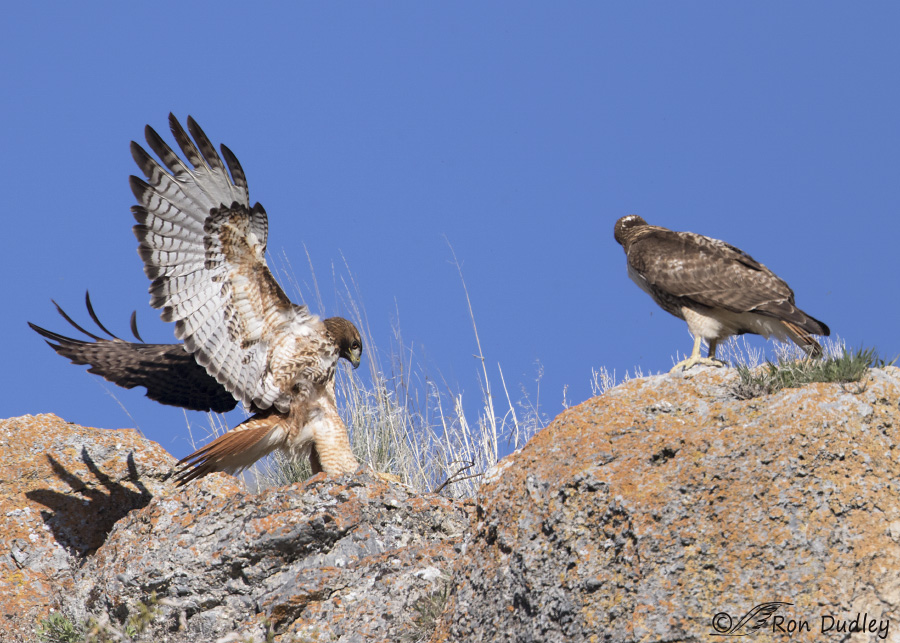
1/2500, f/6.3, ISO 400, Canon 7D Mark II, Canon EF 500mm f/4L IS II USM + 1.4 tc, not baited, set up or called in
I photographed this mated pair of red-tails yesterday morning in northern Utah. They’re still constructing their nest and copulating so apparently eggs haven’t yet been laid. The female was particularly industrious in carrying twigs to the nest and here she’s landing next to her mate on a tall cliff that overlooks the nest. She has a twig in her talons but only a portion of it can be seen in the notch in the rocks in front of her. I wish the male hadn’t been looking away when I took this shot.
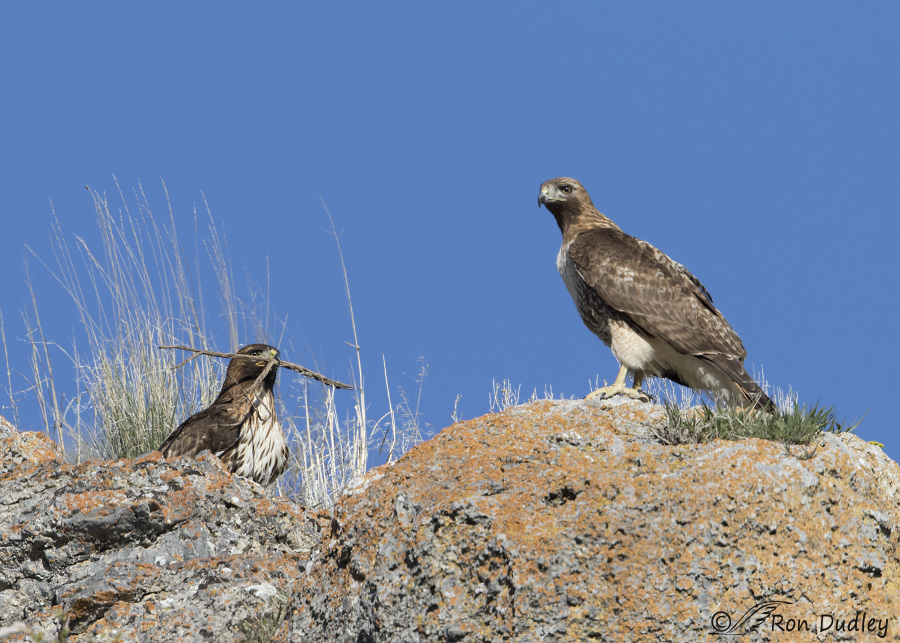
1/2500, f/7.1, ISO 400, Canon 7D Mark II, Canon EF 500mm f/4L IS II USM + 1.4 tc, not baited, set up or called in
After she landed she rested for a few moments and then transferred the twig to her beak for the final leg of her journey to the nest.
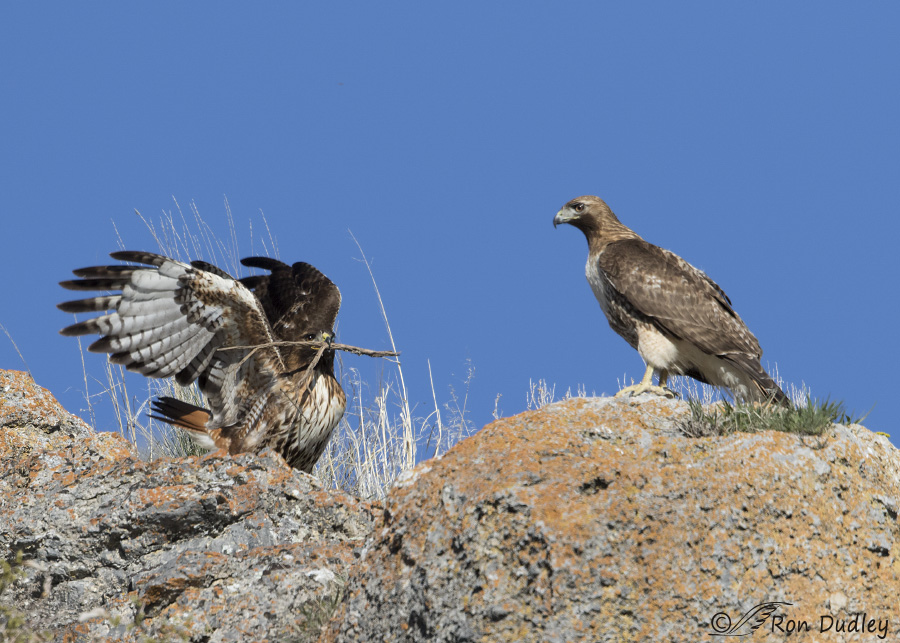
1/2500, f/7.1, ISO 400, Canon 7D Mark II, Canon EF 500mm f/4L IS II USM + 1.4 tc, not baited, set up or called in
She raised her wings…
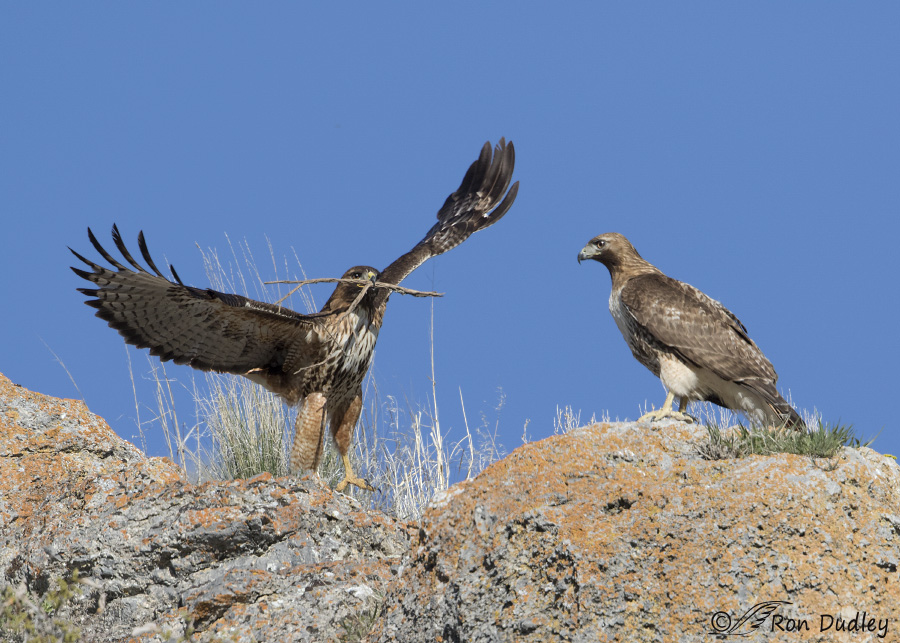
1/2500, f/7.1, ISO 400, Canon 7D Mark II, Canon EF 500mm f/4L IS II USM + 1.4 tc, not baited, set up or called in
lifted off…
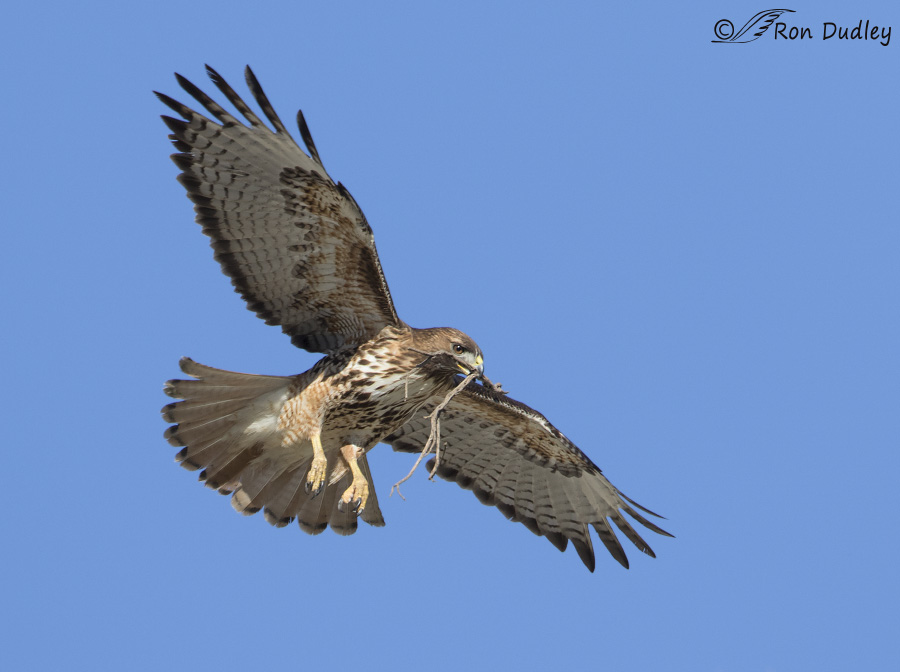
1/1600, f/7.1, ISO 400, Canon 7D Mark II, Canon EF 500mm f/4L IS II USM + 1.4 tc, not baited, set up or called in
and seemed to play in the updraft of the wind coming off the face of the cliff. Here the male and the top of the cliff are just out of frame at the bottom.
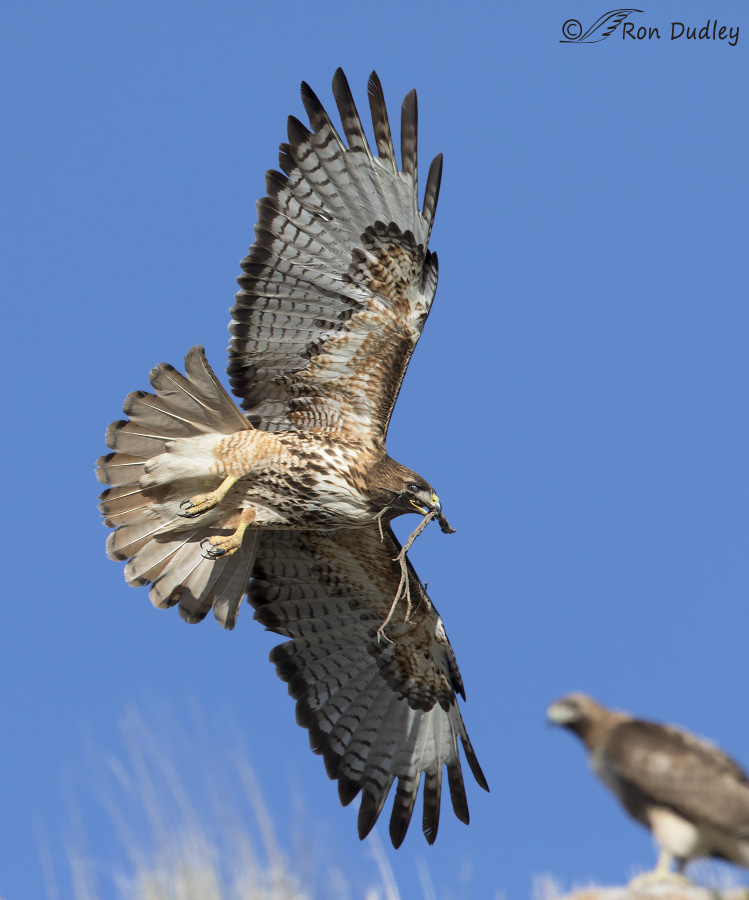 1/1250, f/7.1, ISO 400, Canon 7D Mark II, Canon EF 500mm f/4L IS II USM + 1.4 tc, not baited, set up or called in
1/1250, f/7.1, ISO 400, Canon 7D Mark II, Canon EF 500mm f/4L IS II USM + 1.4 tc, not baited, set up or called in
This last shot kind of broke my heart. She banked beautifully giving me a great look at her underside with her tail flared. There’s also good light on her face, grasses at the bottom of the frame to “ground” the image and the out of focus male watching her in the background helps to tell the story.
But dammit, her nictitating membrane is half closed and I cut off the rear end of the male!
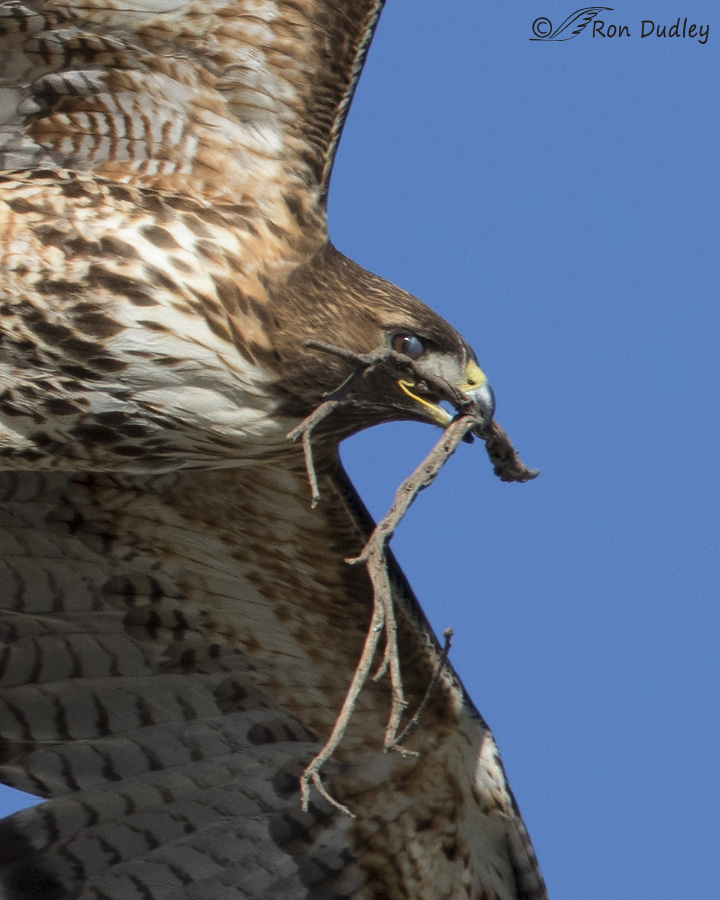
A very large crop of the previous images gives us a better look at the culprit – that partially closed membrane. I’ve noticed that when she’s carrying nesting material in her beak the membrane is often closed to protect the eye. With the stick so close to her eye that makes sense but it sure detracts from a lot of potentially interesting photographs.
Oh well, I’m still glad I captured the shot and after all it does demonstrate an interesting feature of birds – the nictitating membrane.
Ron


Ron, I’m struggling hard with the PC way of making this comment. Here’s the best I can do: over the years you have commented about not liking particular pictures due to the nictitating membrane showing. Up till now, those birds haven’t changed. They still have nictitating membranes, probably because the birds have a better survival rate with their use.
What could change is your way of looking at those beautiful adaptations that have helped these modern dinasaurs survive and fluorish today.
Ron, I love your stunning photographs, and I especially love the action series that show the real life of the bird. I may not love the duck innards in the peregrine’s beak, but that tells a real nature story and we all, coexisting in this wonderful universe, share that story.
I’m asking for more photographs with more truth, nictitating membranes and all.
I’m trying to get down off of the soapbox.
I love your photographs.
Sue
Sue Johnson, mind if I join you on your soap box? 🙂 I’m passionate about these birds however they present themselves and I want to see them in all their glory.
I really enjoy your stories complete with photos!!
Great shots, Ron. I like seeing the membrane half covering the eye. Now I know what it’s for! As for cutting off the male. Well, he wasn’t much help anyway. 🙂
“As for cutting off the male. Well, he wasn’t much help anyway”
That made me smile, Jane. I needed that this morning.
Ron until you mentioned it I had not noticed the membrane. Actually to the uneducated, like me, it just looks like a white of an eye in the not-close up photo.
We are our on worst critics.
But I am guessing that among your peers you are a very excellent photographer because of your criticism.
Are you permitted to photoshop the membrane ?
Great Job
“Are you permitted to photoshop the membrane?”
I don’t permit myself to do it, David.
Wonderful shots Ron!
I enjoyed seeing that in fact they half or fully close the nictitating membrane when dealing with sticks for their nest.
I suspected that, but there is nothing like a photograph to prove it happens.
Thanks,Dick, I’m not sure the membrane was held in a half-closed position. It may be that my shutter speed just captured it in that position as it was opening or closing.
Great shots Ron, and thanks for the teaching moments. Is the nictitating membrane on the red tail autotomic or do they activate it if they think they need it? I have a pair that nest in one of my cottonwood trees. A few years ago I was moving sprinkler pipe in the horse pasture and unknowingly disturbed a newly hatched batch of baby killdeers. They started peeping and scattered in different directions. The red tail in the top of the nearby tree quickly dove down and grabbed one about 20 feet away from me. It was so quick and silent, I only got to see it because I saw a movement out of the corner of my eye.
Marvin, Birds can actively control their membrane, though I suspect that it can also be a reflex – much like blinking is with us.
Sigh…such raw, exquisite and magnificent beauty! As you know, redtails have captured my heart, fully and completely and you’ve caught slices of their lives in beautiful detail. I’ve been at this falconry thing for 22 years now (with close raptor watching for 25 years or more–I’ve lost count), and every time I see a redtail, my heart sings with sheer joy. Yes, there is the issue that my favorite bird is the one I’m looking closely at right this second, but redtails (and HAHAs and AMKEs and oh never mind…) hold a special place.
I just love the detail in the feathers, the postures, the outstretched wings and yes, even the nictitating membrane, too! There’s also that sheer audacity of flight–for those of us stuck in this two-legged, stuck-to-the-ground gravity thing with neither wings nor feathers to take us into the sky. Again, here’s that ridiculously redundant OH WOW!
Thank you for starting my morning off right!
I figured you might enjoy this one, Laura. Thank you.
Oh I meant to add that the two-stage delivery is not all that unusual. They don’t often fly a straight shot to the nest location, but instead stop and have a look around for any possible predators before heading to the nest. My chat moderator time came up and that slipped out of my head, along with so many other things 🙂
That makes sense, Laura.
On the other hand, on this same morning I watched a nest-building Swainson’s Hawk make repeated straight shots to the nest with nesting material with no “two-stage” involved in any of the trips. I guess it depends on the situation, the bird and maybe the species of raptor.
Yes, not to mention all the other variables that we don’t know–that THEY know! There’s so much we don’t know. Sigh…
These are all great shots…particulary like first and second showing his vigilance and the fifth…showing such great detail , including the protective membrane over the eye. You don’t usually think of nest building as hazardous, but this reminds us that it can be…their whole life, almost all their activities have elements of danger. An eye injury can make successful hunting impossible and therefore be a horrible death sentence…
You’re right about raptors and eye injuries, Patty. I’ve seen quite a few, though mostly in owls.
Beautiful pictures. I love seeing all the details of these gorgeous creatures. We have a hawk that frequents our neighborhood. He sits on the top of a tall pine tree often. I was concerned for a while he was keeping an eye on my little schnauzer!! I came out onto the patio one day and he was sitting on a rock next to our small pond.
Nice work.
Carol, it’s great that you have that hawk in your neighborhood. I wish I had the same opportunity. All we get in my neighborhood is the occasional kestrel and Cooper’s Hawk.
I recently had the pleasure of spotting a red-tailed hawk visiting and landing on a bush in the front of my house here in South Dakota. I live in the city of Sioux Falls and didn’t expect to ever see a hawk in my neighborhood. I assumed that they really only touched down in less populated areas. It was the first time I have ever seen one so close. I was able to look at it through my living room window and front door. I captured a couple of photos of it that aren’t near as crisp and beautiful as the ones you capture. It’s incredible to see this hawk’s outstretched wings in all its glory. I feel that you capture the truth of the moment with the birds you photograph and in that truth, beauty always resides as well. I never knew that these hawks can close part of their membrane in order to protect their eye as they fly so I’m grateful that you captured that truth.
Sarah, In some areas Red-tailed Hawks can be fairly common in the city though I almost never see them in my own neighborhood. Thank you.
Nice series of images, Ron. I’m constantly amazed by the quality of your images and what you’re able to shoot from your truck. I feel your frustration as I, too, prefer a clear, bright eye in my photos. And while it is somewhat a shame about cutting off the male, at least he was just a supporting actor and not the lead.
Good point about the male, Dave. I think cutting him off was the lesser of the two significant weaknesses of that image.
Shooting from my truck definitely has advantages and disadvantages. A vehicle is a great mobile blind since birds tend to be much less fearful of them than of folks on foot. But my mobility shooting out the window is significantly reduced when compared to shooting from a tripod or handholding. I felt that frustration yesterday while photographing these hawks.
I realize you are probably driving & stop to shoot out the window. But can you open the door to free up the shooting window or careful slip into the bed of the truck?
Silly questions, I’m sure u have thoughts out l of these 😉
No, David, I’m afraid I can’t. Typically birds will flee if I even begin to crack the door. It’s amazing how sensitive they are to that. Inside I’m also in the shade (less obvious to the birds) and being inside muffles the sound of my shutter.
If I am out photographing birds I leave my window open no matter what the weather. I have had birds fly away at the sound of a car window rolling down.
Great series and great pics. As always…tack sharp.
Thanks very much, Zaphir.
Great series, Ron! 🙂 The nictitating membrane may be a distraction to you but it does capture what was going on.:) The detail in all the photos is wonderful.
I can see it both ways, Judy – though I must admit that if I had a choice I’d rather not be seeing the membrane.
Great! series of photos. As always, thank you for sharing with us.
Thank you, CaJ.
Sensational behavioral shots Ron! I rather liked the half master nictitating membrane.
Charlotte
I thought it was interesting too, Charlotte, though I think the partially closed membrane detracts from the aesthetics of the image. I guess its value depends on the purpose of the shot…